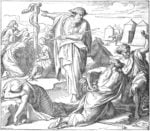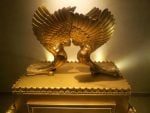
Breaking Symmetry to Inaugurate the Priests
The Torah portion Tzav describes a ritual performed by Moses in consecrating Aaron as the High Priest (Kohen Gadol) and his sons as priests (kohanim):

The Torah portion Tzav describes a ritual performed by Moses in consecrating Aaron as the High Priest (Kohen Gadol) and his sons as priests (kohanim):

In his commentary on this week’s Torah Portion, Yitro, Rabbi Chayim Vital, writing in the name of his teacher, the Ari-zal, states that Abel was

Introduction What could the Standard Model of particle physics possibly have in common with biblical accounts of the Israelites’ travels in the Sinai Desert, Kabbalistic
Structurally identical biblical accounts of creation, destruction, and restoration are viewed as a manifestation of dialectic triad thesis-antithesis-synthesis.

And Abraham rose early in the morning, and saddled his ass. Geneses 22:3 And Moses took his wife and his sons, and set them upon

We are quite familiar with space—we move freely in space back and forth; we concur space on land and beyond; we reclaim land from sea;

So the present passed over before him; and he himself lodged that night in the camp. And he rose up that night, and took his

A Study in Form and Matter And Moses prayed for the people. And the Eternal said unto Moses: “Make thee a fiery serpent, and set it

And Nadab and Abihu, the sons of Aaron, took each of them his censer, and put fire therein, and laid incense thereon, and offered strange

The Torah portion Vayakhel deals with the construction of the Mishkan, i.e., the “Tabernacle.” In Kabbalah, the Mishkan is viewed as a microcosm that represents

On the Eve of Shabbat, we received a government mailing containing documents that we were required to fill out and send back to the Census

Then drew near the daughters of Zelophehad …. of the families of Manasseh, the son of Joseph; and these are the names of his daughters:

The Lord spoke to Moses, saying: Speak to the children of Israel and you shall say to them that they shall make for themselves fringes

And Moses said: “Thus saith the Lord: About midnight will I go out into the midst of Egypt; and all the first-born in the land of

And Moses turned, and went down from the mount, with the two tablets of the testimony in his hand; tablets that were written on both

And the Eternal spoke unto Moses, after the death of the two sons of Aaron, when they drew near before the Eternal and died. (Leviticus

And thou shalt make two cherubim of gold; of beaten work shalt thou make them, at the two ends of the ark-cover. And make one

As I wrote in my post, Schrödinger Menorah: Burning And Not Burning, the Lubavitcher Rebbe, Rabbi Menachem Mendel Schneerson, explains the miracle of Chanukah as
And these are the years of the life of Ishmael: one hundred years and thirty years and seven years (Gen. 25,17) You might say the

Now, therefore, write ye this song for you, and teach thou it the children of Israel.” (Deut. 31:19) The four known fundamental forces are: gravitational

In the Torah portion Shlach (Numbers 13:1-15:41), Moses instructs his spies to scout the land of Canaan and to bring back a report. He says

The blessings and the admonitions of Bechukotai (Leviticus 26:3–27:34) are viewed as the result of entanglement and disentanglement with G‑d respectively.

Balak the son of Zippor saw all that Israel had done to the Amorites. Moab became terrified of the people, for they were numerous, and
This post is a continuation of the earlier post, The End of Days I. In this Torah Portion, Shemot, we read about the encounter between
Today is the eighth day of the month of Tevet. On the 8th of Tevet of the Jewish year 3515 (246 BCE), the Torah was

These are the journeys of the children of Israel… (Numbers 33:1) When G-d brought the Jews out from Egypt, He brought them out with the mystery of

A strange episode at the end of the last Torah portion, Balak, where Phinehas (Pinchas) slain a Jewish prince caught in the act with a
…And they prophesied in the camp. (Num. 11:27) In the Torah portion Behaalotecha, there is an interesting narrative: And the Lord said unto Moses: ‘Gather

In quantum mechanics, the state of a physical system is described by the so-called wave function (or the “wavefunction”). All attempts by Schrödinger, who first

The Torah portion of Yitro (Ex. 18), is the high point of the story of Exodus—the giving of the Decalogue on Mount Sinai. In a strange
Do you like riddles? Here is a riddle – what do these two figures represent in the context of Exodus? No Idea? How about

There is a continuous thread about the mastery of time that weaves through the last chapters of the book of Genesis (Bereshit) and continues through

It is unsurprising, then, that spiritual phenomena have never been experimentally detected in a laboratory setting. Spirituality, by definition, is non-physical. Consequently, no physical laboratory

…And behold, the thorn bush was burning with fire, but the thorn bush was not being consumed.” (Ex. 3:2) Every theologian worth his salt along

And the angel of the Eternal appeared unto him in a flame of fire out of the midst of a bush; and he looked, and,

Koraḥ the son of Yitzhar, the son of Kehos, the son of Levi took [himself to one side] along with Dasan and Aviram, the sons